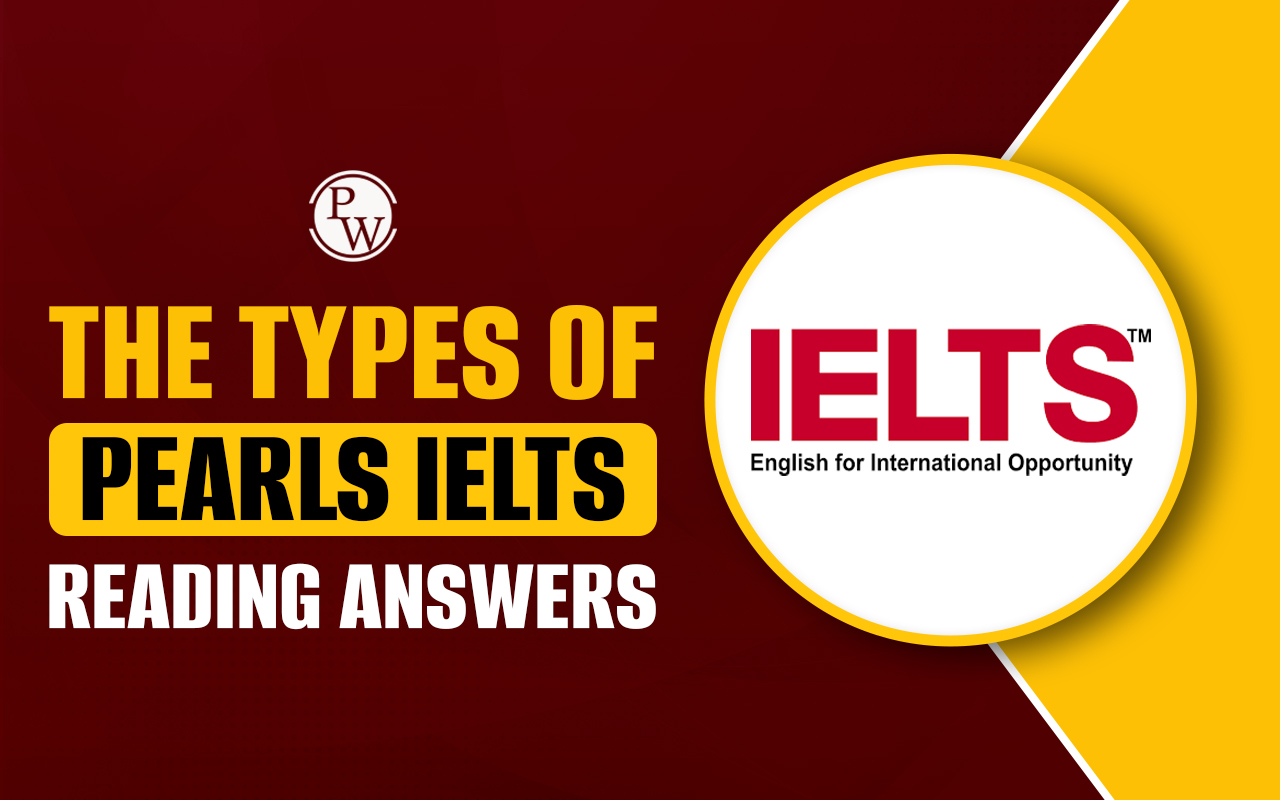

The Types Of Pearls IELTS Reading Answers: The IELTS Reading comprehension is designed to test basic understanding of the reading and analysing skills of candidates applying for a study or work abroad. Solving the passage questions can help to sharpen your interpretation skills and accuracy. Here, we have offered “The Types Of Pearls IELTS Reading Answers” passage, sample questions, and model answers. Solving these sample questions can enhance the problem-solving efficiency of aspirants in various categories including True, False, Not Given questions, Matching Features, Sentence Completion, and more.
The IELTS Reading test assesses the candidate's ability to understand and interpret written texts, skim and scan for information, understand the structure of texts, and more. Solving the “The Types Of Pearls IELTS Reading Answers” can help candidates to better understand the IELTS test pattern and question types. Read the complete writing samples to achieve a high IELTS band score .Free IELTS Reading Practice Tests, Cambridge Sample Test PDF
The Types Of Pearls IELTS Reading Answers Passage
Spend around 20 minutes on Questions 1-14, depending on the “The Types Of Pearls IELTS Reading Answers” Passage below.The Pearl Reading Passage
1. Throughout history, pearls have held a unique presence within the wealthy and powerful. For instance, the pearl was the favoured gem of the wealthy during the Roman Empire. This gift from the sea had been brought back from the orient by the Roman conquests. Roman women wore pearls to bed so they could be reminded of their wealth immediately upon waking up. Before jewellers learned to cut gems, the pearl was of greater value than the diamond. In the Orient and Persia Empire, pearls were ground into powders to cure anything from heart disease to epilepsy, with possible aphrodisiac uses as well. Pearls were once considered an exclusive privilege for royalty. A law in 1612 drawn up by the Duke of Saxony prohibited the wearing of pearls by the nobility, professors, doctors, or their wives in an effort to further distinguish royal appearance. American Indians also used freshwater pearls from the Mississippi River as decorations and jewellery. 2. There are essentially three types of pearls: natural, cultured, and imitation. A natural pearl (often called an Oriental pearl) forms when an irritant, such as a piece of sand, works its way into a particular species of oyster, mussel, or clam. As a defense mechanism, the mollusk secretes a fluid to coat the irritant. The layer upon layer of this coating is deposited on the irritant until a lustrous pearl is formed. 3. The only difference between natural pearls and cultured pearls is that the irritant is a surgically implanted bead or piece of shell called Mother of Pearl. Often, these shells are ground oyster shells that are worth significant amounts of money in their own right as irritant-catalysts for quality pearls. The resulting core is, therefore, much larger than in a natural pearl. Yet, as long as there are enough layers of nacre (the secreted fluid covering the irritant) to result in a beautiful, gem-quality pearl, the size of the nucleus is of no consequence to beauty or durability. 4. Pearls can come from either salt or freshwater sources. Typically, saltwater pearls tend to be higher quality, although there are several types of freshwater pearls that are considered high in quality as well. Freshwater pearls tend to be very irregular in shape, with a puffed rice appearance, the most prevalent. Nevertheless, it is each individual pearl’s merits that determines value more than the source of the pearl. Saltwater pearl oysters are usually cultivated in protected lagoons or volcanic atolls. However, most freshwater cultured pearls sold today come from China. Cultured pearls are the response of the shell to a tissue implant. A tiny piece of mantle tissue from a donor shell is transplanted into a recipient shell. This graft will form a pearl sac and the tissue will precipitate calcium carbonate into this pocket. There are a number of options for producing cultured pearls: use freshwater or seawater shells, transplant the graft into the mantle or the gonad, add a spherical bead or do it non-beaded. The majority of saltwater cultured pearls are grown with beads. 5. Regardless of the method used to acquire a pearl, the process usually takes several years. Mussels must reach a mature age, which can take up to 3 years, and then be implanted or naturally receive an irritant. Once the irritant is in place, it can take up to another 3 years for the pearl to reach its full size. Often, the irritant may be rejected, the pearl will terrifically misshapen, or the oyster may simply die from disease or countless other complications. By the end of a 5 to 10-year cycle, only 50% of the oysters will have survived. And of the pearls produced, only approximately 5% are of substantial quality for top jewellery makers. From the outset, a pearl farmer can figure on spending over $100 for every oyster that is farmed, of which many will produce nothing or die. 6. Imitation pearls are a different story altogether. In most cases, a glass bead is dipped into a solution made from fish scales. This coating is thin and may eventually wear off. One can usually tell an imitation by biting on it. Fake pearls glide across your teeth, while the layers of nacre on real pearls feel gritty. The Island of Mallorca (in Spain) is known for its imitation pearl industry. Quality natural pearls are very rare jewels. The actual value of a natural pearl is determined in the same way as it would be for other “precious” gems. The valuation factors include size, shape, and colour, quality of surface, orient, and lustre. In general, cultured pearls are less valuable than natural pearls, whereas imitation pearls almost have no value. One way that jewellers can determine whether a pearl is cultured or natural is to have the gem lab perform an x-ray of the pearl. If the x-ray reveals a nucleus, the pearl is likely a bead-nucleated saltwater pearl. If no nucleus is present, but irregular and small dark inner spots indicating a cavity are visible, combined with concentric rings of organic substance, the pearl is likely cultured freshwater. Cultured freshwater pearls can often be confused for natural pearls which present as homogeneous pictures that continuously darken toward the surface of the pearl. Natural pearls will often show larger cavities where organic matter has dried out and decomposed. Although imitation pearls look the part, they do not have the same weight or smoothness as real pearls, and their luster will also dim greatly. Among cultured pearls, Akoya pearls from Japan are some of the most lustrous. A good quality necklace of 40 Akoya pearls measuring 7 mm in diameter sells for about $1,500, while a super-high-quality strand sells for about $4,500. Size, on the other hand, has to do with the age of the oyster that created the pearl (the more mature oysters produce larger pearls) and the location in which the pearl was cultured. The South Sea waters of Australia tend to produce the larger pearls; probably because the water along the coastline is supplied with rich nutrients from the ocean floor. Also, the type of mussel common to the area seems to possess a predilection for producing comparatively large pearls. 7. Historically, the world’s best pearls came from the Persian Gulf, especially around what is now Bahrain. The pearls of the Persian Gulf were naturally created and collected by breath-hold divers. The secret to the special lustre of Gulf pearls probably derived from the unique mixture of sweet and saltwater around the island. Unfortunately, the natural pearl industry of the Persian Gulf ended abruptly in the early 1930s with the discovery of large deposits of oil. Those who once dove for pearls sought prosperity in the economic boom ushered in by the oil industry. The water pollution resulting from spilt oil and indiscriminate over-fishing of oysters essentially ruined the once pristine pearl-producing waters of the Gulf. Today, pear diving is practised only as a hobby. Still, Bahrain remains one of the foremost trading centres for high-quality pearls. In fact, cultured pearls are banned from the Bahrain pearl market, in an effort to preserve the location’s heritage. Nowadays, the largest stock of natural pearls probably resides in India. Ironically, much of India’s stock of natural pearls came originally from Bahrain. Unlike Bahrain, which has essentially lost its pearl resource, traditional pearl fishing is still practised on a small scale in India.The Types Of Pearls IELTS Reading Answers Sample Questions
The Types Of Pearls IELTS Reading Answers: True, False, Not Given (Q. 1-3):Questions : 1. Pearls were once considered more valuable than diamonds. 2. Cultured pearls are produced using the same method as imitation pearls. 3. The Persian Gulf's pearl industry declined due to overfishing and pollution.
The Types Of Pearls IELTS Reading Answers: Matching Features (Q. 4-11):Features: A. Akoya pearls B. Natural pearls from Bahrain C. Cultured pearls from China D. South Sea pearls from Australia E. Imitation pearls from Spain F. Freshwater pearls from the Mississippi River G. Pearls used for medicinal purposes H. Pearls used by Native Americans I. Pearls with irregular shapes J. Pearls known for their large size K. Pearls popular during the Roman Empire Questions: 4. Pearls often ground into powder for health benefits. 5. Pearls that are dipped in a fish scale solution. 6. Pearls known for their high luster and expensive price. 7. Pearls traditionally harvested by breath-hold divers. 8. Pearls collected from a river in the United States. 9. Pearls that tend to be irregular and shaped like rice. 10. Pearls produced by mature oysters in nutrient-rich waters. 11. Pearls once worn by Roman women to signify wealth.
The Types Of Pearls IELTS Reading Answers: Sentence Completion (Q. 12-14): Complete the sentences below using NO MORE THAN TWO WORDS from the passage.12. Natural pearls form when an irritant is coated by __________. 13. The majority of cultured freshwater pearls today are produced in __________. 14. The Persian Gulf’s pearl industry ended with the discovery of __________.
The Types Of Pearls IELTS Reading Answers with Explanations
Ans 1. Answer : Pearls were once considered more valuable than diamonds. – TRUE Explanation : The passage states, "Before jewellers learned to cut gems, the pearl was of greater value than the diamond." Ans 2. Answer : Cultured pearls are produced using the same method as imitation pearls. – FALSE Explanation : The passage clarifies that cultured pearls are formed by implanting a bead or shell, while imitation pearls are made by dipping glass beads in fish scale solution. Ans 3. Answer : The Persian Gulf's pearl industry declined due to overfishing and pollution. – TRUE Explanation : The passage notes, "The water pollution resulting from spilt oil and indiscriminate over-fishing of oysters essentially ruined the once pristine pearl-producing waters of the Gulf." Ans 4. Answer : Pearls often ground into powder for health benefits. – G (Pearls used for medicinal purposes) Explanation : The passage mentions, "In the Orient and Persia Empire, pearls were ground into powders to cure heart disease to epilepsy." Ans 5. Answer : Pearls that are dipped in a fish scale solution. – E (Imitation pearls from Spain) Explanation : "In most cases, a glass bead is dipped into a solution made from fish scales. The Island of Mallorca (in Spain) is known for its imitation pearl industry." Ans 6. Answer : Pearls known for their high luster and expensive price. – A (Akoya pearls) Explanation : "Akoya pearls from Japan are some of the most lustrous. A good quality necklace sells for about $1,500, while a high-quality strand sells for about $4,500." Ans 7. Answer : Pearls traditionally harvested by breath-hold divers. – B (Natural pearls from Bahrain) Explanation : Paragraph G states, "The pearls of the Persian Gulf were naturally created and collected by breath-hold divers." Ans 8. Answer : Pearls collected from a river in the United States. – F (Freshwater pearls from the Mississippi River) Explanation : Paragraph A states, "American Indians also used freshwater pearls from the Mississippi River as decorations and jewellery." Ans 9. Answer : Pearls that tend to be irregular and shaped like rice. – I (Pearls with irregular shapes) Explanation : Paragraph D states, "Freshwater pearls tend to be very irregular in shape, with a puffed rice appearance, the most prevalent." Ans 10. Answer : Pearls produced by mature oysters in nutrient-rich waters. – D (South Sea pearls from Australia) Explanation : Paragraph F states, "The South Sea waters of Australia tend to produce the larger pearls; probably because the water along the coastline is supplied with rich nutrients from the ocean floor." Ans 11. Answer : Pearls once worn by Roman women to signify wealth. – K (Pearls popular during the Roman Empire) Explanation : Paragraph A states, "Roman women wore pearls to bed so they could be reminded of their wealth immediately upon waking up." Ans 12. Answer : Natural pearls form when an irritant is coated by nacre. Explanation : Paragraph D states, "As a defense mechanism, the mollusk secretes a fluid to coat the irritant." Ans 13. Answer : The majority of cultured freshwater pearls today are produced in China. Explanation : Paragraph D states, "Most freshwater cultured pearls sold today come from China." Ans 14. Answer : The Persian Gulf’s pearl industry ended with the discovery of oil. Explanation : Paragraph G states, "The natural pearl industry of the Persian Gulf ended abruptly in the early 1930s with the discovery of large deposits of oil."| IELTS Exam Important Links | |
|---|---|
| IELTS Reading Band Score | IELTS Listening Band Score |
| IELTS Speaking Band Score | IELTS Writing Band Score |
The Types Of Pearls IELTS Reading Answers Tips
Here's a table with tips on how to solve IELTS Reading passages like "The Types of Pearls":| Question Type | Tips to Solve The Types Of Pearls IELTS Reading Answers |
|---|---|
| True, False, Not Given | Locate keywords in the question and scan the passage for them. |
| Look for direct statements that confirm or contradict the question. | |
| If no information is found, choose "Not Given." | |
| Focus on absolute words (e.g., "all," "never") – they often indicate False. | |
| Matching Features | Identify the main idea of each option. |
| Skim for unique descriptors (e.g., "Japan," "Spain," "Mississippi River"). | |
| Match by eliminating options that clearly do not fit. | |
| Sentence Completion | Look for specific phrases or paraphrased ideas. |
| Pay attention to word count limits ("NO MORE THAN TWO WORDS"). | |
| Fill in the blanks with exact words from the passage. | |
| General Reading Tips | Skim the passage first to get an overview. |
| Highlight dates, places, and unique terms for quick reference. | |
| Use context clues to infer answers where direct information is missing. |
- Should You Use All Capital Letters in the IELTS Listening and Reading Tests
- IELTS Reading Mistakes
- How to Improve IELTS Reading Score
- How to Manage Time in IELTS Reading
Guidance of PW IELTS
Physics Wallah offers a few popular online IELTS courses for all students. Follow the latest IELTS articles to better prepare for the exam.| IELTS Exam Other Related Links | |
|---|---|
| IELTS Registration | IELTS Eligibility Criteria |
| IELTS Exam Pattern | IELTS Syllabus |
| IELTS Exam Dates | IDP IELTS Test Centers |
The Types Of Pearls IELTS Reading Answers FAQs
Q. What are the three main types of pearls?
Ans. The three main types of pearls are Natural, cultured, and imitation pearls. Natural pearls form naturally in oysters, cultured pearls are man-made, and imitation pearls are usually glass beads coated with fish scale solution.
Q. How can you tell if a pearl is real or fake?
Ans. If we bite the pearl lightly, the real pearls feel gritty due to nacre layers, however, fake pearls glide smoothly over teeth.
Q. Why did the Persian Gulf's pearl industry decline?
Ans. The Persian Gulf's pearl industry declined in the 1930s due to oil discovery, pollution, and overfishing of oysters, which ruined pearl-producing waters.
Q. Which pearls are known for their high luster and quality?
Ans. Akoya pearls from Japan are known for their high luster and quality. The cost of a quality Akoya pearl necklace can range between $1,500 and $4,500.
Talk to a counsellorHave doubts? Our support team will be happy to assist you!

Check out these Related Articles
Free Learning Resources
PW Books
Notes (Class 10-12)
PW Study Materials
Notes (Class 6-9)
Ncert Solutions
Govt Exams
Class 6th to 12th Online Courses
Govt Job Exams Courses
UPSC Coaching
Defence Exam Coaching
Gate Exam Coaching
Other Exams
Know about Physics Wallah
Physics Wallah is an Indian edtech platform that provides accessible & comprehensive learning experiences to students from Class 6th to postgraduate level. We also provide extensive NCERT solutions, sample paper, NEET, JEE Mains, BITSAT previous year papers & more such resources to students. Physics Wallah also caters to over 3.5 million registered students and over 78 lakh+ Youtube subscribers with 4.8 rating on its app.
We Stand Out because
We provide students with intensive courses with India’s qualified & experienced faculties & mentors. PW strives to make the learning experience comprehensive and accessible for students of all sections of society. We believe in empowering every single student who couldn't dream of a good career in engineering and medical field earlier.
Our Key Focus Areas
Physics Wallah's main focus is to make the learning experience as economical as possible for all students. With our affordable courses like Lakshya, Udaan and Arjuna and many others, we have been able to provide a platform for lakhs of aspirants. From providing Chemistry, Maths, Physics formula to giving e-books of eminent authors like RD Sharma, RS Aggarwal and Lakhmir Singh, PW focuses on every single student's need for preparation.
What Makes Us Different
Physics Wallah strives to develop a comprehensive pedagogical structure for students, where they get a state-of-the-art learning experience with study material and resources. Apart from catering students preparing for JEE Mains and NEET, PW also provides study material for each state board like Uttar Pradesh, Bihar, and others
Copyright © 2025 Physicswallah Limited All rights reserved.











